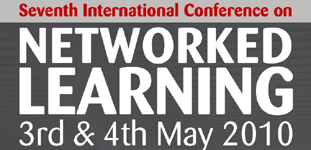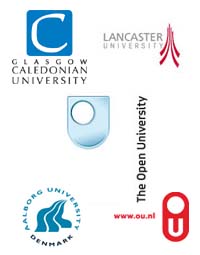

Current challenges in learning design and pedagogical patterns research
Symposium Organiser: Gráinne Conole, Open University, UK
Introduction
The goal of this symposium is to bring together experts in learning design and pedagogical patterns research to exchange their current views on learning design as well as their experiences in evaluating the application of their proposed approaches in practice. Four papers are included, which between them they cover different aspects of the following three themes: i) Approaches to visualising and representing design patterns, ii) Computational representation of enacted patterns and iii) Analyses of emerging enacted patterns. In particular we are interested in exploring how can designs be represented, shared and discussed, and how they might be used and by whom. The first paper acts as a position paper in relation to the remaining four. It provides an overview of different types of design representations and demonstrates how these can be used in different contexts. The second explores design aspects around creativity and collaboration. Collaborative design is also picked up in the third paper, but in the context of pedagogical patterns. The final paper looks at issues to do with sharing and discussing designs and puts forward a number of theoretical frameworks for understanding new emergent practices in web 2.0 spaces. The symposium will use the content of the papers as a basis for exploring the three themes and will attempt to draw out new insights into addressing these questions.
Modern networked learning environments have the potential to enhance significantly the student learning experience; offering new ways in which they can communicate and interact with each other and with their tutors. However, the sheer variety of new technologies available now is bewildering. Those tasked with designing learning experiences need new forms of guidance to take advantage of the affordances of new technologies and to make pedagogically informed design decisions. The learning design and pedagogical patterns research fields that have emerged in recent years are attempting to provide solutions to these issues. Learning design research is concerned with articulating and representing the design process and providing tools and methods to help designers in their design process (Lockyer et al., 2008). Pedagogical patterns research is concerned with elicited empirically derived good practice and representing that within a standard format according to the underlying pedagogical pattern principles (Retalis and Goodyear, forthcoming). This series of papers provides a snapshot of current thinking in these fields. The symposium will aim to draw out some common synergies across these fields. These fields are related, but distinct from instructional design research (Spector et al., 2008; Reigeluth et al. 2009); learning design because of its emphasis on the holistic design process and its alignment to a socio-cultural perspective and pedagogical patterns in terms of its derivation from Alexander’s work in Architecture.
Designing effective technology-enhanced learning environments in an efficient and affordable way is a demanding task, which requires creativity and a significant amount of expertise [Goodyear, 2002]. On the one hand, people new to e-learning design need advice from experts, experienced peers, and users so as to avoid investing a large amount of resources in ‘re-inventing the wheel’ or in creating solutions that may be educationally ineffective. On the other hand practitioners, instructional designers and content experts need to effectively collaborate for the joint development of learning designs thus leading to an increase of the quality of e-learning provision across Europe. Currently, several initiatives have been set up and a lot of attempts have been made in order to explore conceptualizations of learning designs such as IMS LD, educational modelling languages like EML, learning flow design patterns, pedagogical patterns and of course visual tools for creating learning designs. The learning design research community faces a big challenge: to find powerful ways of providing structured, teacher-friendly, formalized and visual representations of learning designs.
An overview of design representations
Gráinne Conole, Open University, UK
Abstract
This paper provides an overview of the range of representations that can be used to describe learning designs. It provides a definition for learning designs and demonstrates how the different representations can be used for different levels of granularity and to foreground different aspects of the design process.
Designing Collaborative Learning Sessions that Promote Creative Problem Solving Using Design Patterns
Symeon Retalis, Mary Katsamani, Petros Georgiakakis, Georgia Lazakidou, Ourania Petropoulou
University of Piraeus, Department of Technology Education and Digital Systems, Piraeus, Greece
Theodoros Kargidis
Technological Institute of Thessaloniki, Department of Marketing, Greece
Abstract
Solving problems is considered as a very important learning activity in formal educational settings concerning all grades of education from primary to tertiary education. Students’ engagement in problem solving activities helps them to acquire not only knowledge and skills on a subject domain but also useful attitudes such as thinking, flexibility, creativity, and productivity which are very important to real life. As a result numerous problem solving models and creativity techniques, mostly collaborative ones, have been proposed for aiding students solve problems. These models specify the steps of a systematic process of solution-building for a given problem description. One main open research question is “how can students learn how to apply a problem solving model”? Research has demonstrated the potential of collaborative learning sessions for enhancing young children's cognitive development and learning. The scope of this paper is to show how collaborative learning flow patterns (CLFP) can help teachers to design effective interactive learning scenarios based on well defined strategies such as Jigsaw, TPS and others that can help students learn apply problem solving models and at the same time acquire higher-order thinking skills. It is argued that CLFPs are a designer friendly way to portray the coordination and the sequencing of tasks during the learning process as well as the rationale behind them. We will present a CLFP of a collaborative problem solving strategy called e-ARMA in an attempt to explain the added value of the use of CLFPs for designing learning sessions that foster the acquisition of creative problem solving skills.
Recurrent routines in the classroom madness: pushing patterns past the design phase
Luis Pablo Prieto, Sara Villagrá-Sobrino, Yannis Dimitriadis, Iván M. Jorrín-Abellán, Alejandra Martínez-Monés, Rocío Anguita-Martínez
University of Valladolid, Spain
Abstract
The notion of pedagogical patterns has proved very useful in the field of learning design, especially with regard to activities for complex educational scenarios, such as computer-supported collaborative learning (CSCL). However, CSCL designs (pattern-based or not) also have to be enacted by teachers, and very often ambiguities, difficulties and deviations arise in this enactment. This paper reports recent experiences in an authentic primary school setting, aimed to study teachers who are not technology experts, designing, enacting and even improvising with a CSCL tool. This study uncovered a set of recurrent routines in the design of activity scripts (which we could see as implicit design patterns), as well as a limited set of routines in the enactment of these activities. The comparison of the designs and their enacted counterparts revealed that the designed routines were completed with additional sets of unexpected routines, bridging the gap between high-level designs and the concrete classroom performance. This paper discusses the idea of eliciting an extensible set of enactment patterns/routines and the level of formalization needed, especially regarding its potential usefulness as a tool (mediating artifact) to support practitioners in enacting CSCL activities in a more flexible and effective way.
Ritual performances and collective intelligence: theoretical frameworks for analysing emerging activity patterns in Cloudworks
Panagiota Alevizou, Gráinne Conole, Juliette Culver and Rebecca Galley
The Open University, UK
Abstract
This paper provides an overview of emerging activity patterns on Cloudworks, a specialised site for sharing and debating ideas as well as resources on teaching, learning and scholarship in education. It provides an overview of activities such as ‘flash debates’, ‘blended workshops’ and ‘open reviews’ and seeks to situate dialogic interchanges and structures of involvement within the following theoretical frameworks: a) Goffman’s notions of ‘face-work’ and ‘ritual performance’; and b) and secondly, notions of collective intelligence. The paper argues that these perspectives can offer a unique contribution to the study and analysis of sociality (Bouman et al, 2007) bounded in the context of technologically mediated networked learning, with wider implications for understanding matters of participation, self-representation, reflection and expansion in education.
| About NLC | Welcome Messages| Acknowledgwments | Conference Proceedings| Keynote Speakers| Index of Presenting Authors| Contact |